Museum Magic
Visiting museums has always been a passion of mine. The experience feeds the mind, body, and soul. It invigorates the senses, challenges the unknown, and dares to force a vision from a different pair of shoes. Museum exploration creates a vision "that goes on deep and permanent in the ideas of living" . (Miriam Beard) My design eye sees the world through a wide angle lens - a gift from the museums I have visited.
The Getty Center - Los Angeles
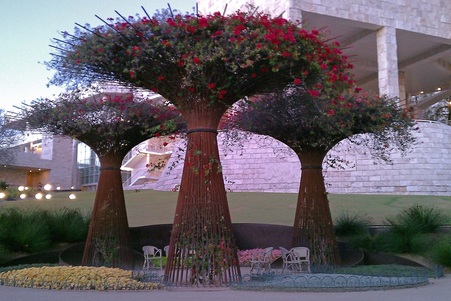
1200 Getty Center Dr
Los Angeles, CA 90049
With so much hoopla and excess in Los Angeles it was pure joy to visit the J. Paul Getty Museum - a serene venue full of inspirational coloring inside and out. The Museum is split onto two campuses: The Getty Villa located in Malibu and The Getty Center located in Brentwood. My visit was to the The Getty Center situated on a hilltop in the Santa Monica Mountains over looking the city and the Pacific Ocean all inside a "backdrop of dramatic architecture, tranquil gardens, and breathtaking views."
The Center houses European paintings, drawings, sculpture, illuminated manuscripts, decorative arts, and European and American photographs. On the day of my visit the Pacific Standard Time: Art in L.A. 1945-1980 attracted my curiosity. http://www.pacificstandardtime.org/ This collection is "an initiative of the Getty with arts institutions across Southern California" that displayed, at this location, a "survey of painting and sculpture drawn from prominent national and international collections offering a fundamental reappraisal of postwar Los Angeles art." Included was the 1963 oil on canvas Standard Station by Ed Ruscha and the over sized works of ceramic sculptor John Mason. The Standard Station boasted the stark contrast of black and white with tomato red and beeswax yellow attracting the eye. Mason's work revealed his innovative ceramic techniques in producing sculptures that reached over five feet in height with the Blue Wall extending twenty-one feet in length.
http://www.edruscha.com/site/workView.cfm?pk=28 http://www.getty.edu/pacificstandardtime/explore-the-era/people/john-mason/
As provoking as the Getty collections were inside I must say that my attention was drawn to the outside - another amazing work of art. Designed by architect Richard Meier the campus exuded The Getty qualities of "permanence, solidity, simplicity, warmth, and craftsmanship." Drawing inspiration from land, sea, and city Meier created a built environment highlighting both culture and nature. http://www.richardmeier.com/www/#/projects/architecture/visual/4/92/5/_ (Note the shadow image in the slide show below. Still afraid of blue and orange together?)
Clad in cleft-cut travertine, steel, and glass the campus is organized around a central plaza and offers framed panoramic views of the city - gorgeous. Curvilinear design elements and natural gardens soften the grid created by the travertine, steel, and glass squares - all elements sized on some derivative of thirty inches creating continuity, order, and calmness. The stone is one of the most remarkable elements of the complex - taking three years to extract, all 1.2 million square feet was cut from the same Italian quarry. The natural birch and sand dollar colored travertine catches the bright Southern California light and on the afternoon of my visit emitted a honeyed warm hue that enriched the already magnificent Pacific coast. I could not resist producing a shadow of myself on this perfect travertine screen brightly lit by the warm amber and apricot hues of the setting sun - cast against the complimentary regatta blue sky in the distance. This is living color!
At The Getty Center I was in my element: art, architecture, nature, sun, water, and color. I simply hated to leave. As the sun finished setting and the dusk colors of straw, butterscotch, and topaz turned to dark hues of capers and smoked pearl it was if the stage curtain had closed and was shouting at me, "Geri, the show is over - get the hell out of here." Really, I think I was the last visitor to get on the tram for transport back to the parking lot six stories under ground. Fabulous, simply a fabulous experience.
http://www.getty.edu/
photos: private collection, gfhayes
Los Angeles, CA 90049
With so much hoopla and excess in Los Angeles it was pure joy to visit the J. Paul Getty Museum - a serene venue full of inspirational coloring inside and out. The Museum is split onto two campuses: The Getty Villa located in Malibu and The Getty Center located in Brentwood. My visit was to the The Getty Center situated on a hilltop in the Santa Monica Mountains over looking the city and the Pacific Ocean all inside a "backdrop of dramatic architecture, tranquil gardens, and breathtaking views."
The Center houses European paintings, drawings, sculpture, illuminated manuscripts, decorative arts, and European and American photographs. On the day of my visit the Pacific Standard Time: Art in L.A. 1945-1980 attracted my curiosity. http://www.pacificstandardtime.org/ This collection is "an initiative of the Getty with arts institutions across Southern California" that displayed, at this location, a "survey of painting and sculpture drawn from prominent national and international collections offering a fundamental reappraisal of postwar Los Angeles art." Included was the 1963 oil on canvas Standard Station by Ed Ruscha and the over sized works of ceramic sculptor John Mason. The Standard Station boasted the stark contrast of black and white with tomato red and beeswax yellow attracting the eye. Mason's work revealed his innovative ceramic techniques in producing sculptures that reached over five feet in height with the Blue Wall extending twenty-one feet in length.
http://www.edruscha.com/site/workView.cfm?pk=28 http://www.getty.edu/pacificstandardtime/explore-the-era/people/john-mason/
As provoking as the Getty collections were inside I must say that my attention was drawn to the outside - another amazing work of art. Designed by architect Richard Meier the campus exuded The Getty qualities of "permanence, solidity, simplicity, warmth, and craftsmanship." Drawing inspiration from land, sea, and city Meier created a built environment highlighting both culture and nature. http://www.richardmeier.com/www/#/projects/architecture/visual/4/92/5/_ (Note the shadow image in the slide show below. Still afraid of blue and orange together?)
Clad in cleft-cut travertine, steel, and glass the campus is organized around a central plaza and offers framed panoramic views of the city - gorgeous. Curvilinear design elements and natural gardens soften the grid created by the travertine, steel, and glass squares - all elements sized on some derivative of thirty inches creating continuity, order, and calmness. The stone is one of the most remarkable elements of the complex - taking three years to extract, all 1.2 million square feet was cut from the same Italian quarry. The natural birch and sand dollar colored travertine catches the bright Southern California light and on the afternoon of my visit emitted a honeyed warm hue that enriched the already magnificent Pacific coast. I could not resist producing a shadow of myself on this perfect travertine screen brightly lit by the warm amber and apricot hues of the setting sun - cast against the complimentary regatta blue sky in the distance. This is living color!
At The Getty Center I was in my element: art, architecture, nature, sun, water, and color. I simply hated to leave. As the sun finished setting and the dusk colors of straw, butterscotch, and topaz turned to dark hues of capers and smoked pearl it was if the stage curtain had closed and was shouting at me, "Geri, the show is over - get the hell out of here." Really, I think I was the last visitor to get on the tram for transport back to the parking lot six stories under ground. Fabulous, simply a fabulous experience.
http://www.getty.edu/
photos: private collection, gfhayes
Los Angeles County Musuem of Art - Los Angeles
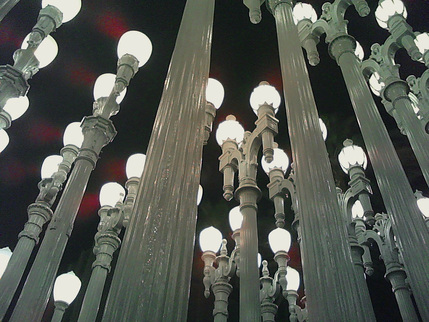
5905 Wilshire Blvd
Los Angeles, California 90036
With time to visit one more museum on my L.A. visit and with so many great museums to choose from, including the Museum of Contemporary Art, I opted to piggy back on the exhibit I viewed at The Getty Center -Pacific Standard Time: Art in L.A. 1945-1980 - showing at the LACMA on Wilshire Boulevard, halfway between the ocean and downtown.
LACMA is the largest museum in Western USA consisting of a seven-building complex located on twenty acres. Time limitation directed my keen eye to the Resnick Pavalion and the Broad Contemporary Art Museum. However, the Urban Light installation, located on Wilshire Boulevard, drew my eye with the its bright glowing lamplights - many many lamp lights of varying sizes and design details that were all painted the same earthy gray. Created by Chris Burden all 202 restored cast iron antique street lamps came from within the city. The street lamps are all powered by solar energy - a given in "green" California.
http://collectionsonline.lacma.org/mwebcgi/mweb.exe?request=record;id=161897;
The walk back through the central courtyard took me past the sidewalk cafe to the Resnick Pavilion that housed one of the three LACMA Pacific Standard Time exhibits - California Design, 1930-1965: "Living in a Modern Way. "This exhibition is the first major study of California midcentury modern design. With more than 300 objects—furniture, ceramics, metalwork, fashion and textiles, and industrial and graphic design—the exhibition examines the state’s role in shaping the material culture of the entire country." Glowing just inside the building's entrance stood a 1936 Airstream Clipper Trailer - now this is vintage living. The Clipper set me into an era of classic design giving me a taste of what was to follow: Charles Eames entire living room (transplanted from Pacific Palisades during renovation), Dick Van Dyke's 1963 Studebaker Avanti, Barbie's 1962 Dream House, Greta Grossman's 1952 Desk, and Margit Fellegi's 1950 glittering gold lame' ladies swimwear. This gathering of California mid-century designers demonstrates just why we are in love with "the look" all over again. Everything was simple, demonstrates functionality without excess - perhaps what we seek in these struggling economic and political times. I recommend exploring the exhibit's companion book dressed in a multi-colored striped cover: California Design, 1930-1965: "Living in a Modern Way", edited by Wendy Kaplan. Turning pages in this book will explain how "California design influenced the material culture of the entire country, in everything from architecture to fashion." My reconnection to many of the designers and designs in this exhibit warmed my soul and energized my appreciation for those simple lines and times. This was a visual experience that will go on deep and permanent in my idea of living.
Walking out of the Resnick Pavilion I was faced head on with the high-risk red structural entrance to the Broad Contemporary Museum. The three story structure was reminiscent of the Pompidou in Paris - both housing stairs and escalators on the outside so as not to interfere with exhibit space inside. (See my Pompidou visit below) Large expansive galleries were home for large scale works including a Richard Serra sculpture ala it's cousin in St. Louis' Downtown Central Mall and Jeffrey Koon's Turkish sea blue venti sized balloon animal. Highlighted the week of my visit was the recent opening of another Chris Burden piece, Metropolis II - "an optimistic vision of the future of car culture" according to Burden. Large in scale at twenty by thirty feet the "miniature city in motion consists of 1,100 Hot Wheels-sized cars, 25 large buildings, 18 lanes of traffic, 13 trains and one human operator." The traffic moves only three times a week for an hour at a time - I unfortunately did not get to see this work of art come to life but you can here.... http://www.fastcodesign.com/1664409/metropolis-ii-a-tiny-city-where-100000-toy-cars-circulate-every-hour Though much smaller than New York's MOMA the Broad offered an easy viewing of the the artists we have loved and many of those we need to love: http://broadartfoundation.org/all_artists.html?sid=32 I look forward to another visit for further exploration.
After another walk past the Urban Lights I headed for my next cultural experience of the evening - the colorful culinary art of Mario Batali at Osteria Mozza. Yum! (see February 8, 2012 entry in Color Box Blog)
http://www.lacma.org/ photos: private collection gfhayes
Museum of Modern Art - New York
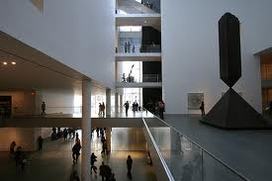
11 West 53rd Street
New York, New York 10019
I can't get enough of the MoMA. Every trip to NYC is not complete until I have stepped inside this museum. I get a creative fix every time I explore the vast open spaces and the small galleries. Every square inch is full of intrigue and fascination. Modern design is now classic design. Love it!
The highlights as described by Forder's Travel guide succinctly states every reason to visit the MoMA on every visit to the big city. "In addition to the artwork, one of the main draws of MoMA is the building itself. A maze of glass walkways permits art viewing from many angles. The 110-foot atrium entrance (accessed from the museum's lobby on either 53rd or 54th Street) leads to the movie theaters and the main-floor restaurant, Modern, with Alsatian-inspired cuisine. A favorite resting spot is the Abby Aldrich Rockefeller Sculpture Garden. Designed by Philip Johnson, it features Barnett Newman's Broken Obelisk (1962-69). The glass wall lets visitors look directly into the surrounding galleries from the garden, where there's also a reflecting pool and trees. Contemporary art (1970 to the present) from the museum's seven curatorial departments shares the second floor of the six-story building, and the sky lit top floor showcases an impressive lineup of changing exhibits."
Oh, least I forget - the MoMA has the best museum gift shop. I find it hard to leave this shop, especially the design store across the street. And, should you be in SoHo there is a MoMA design store there too. Both locations are chocked full of great design all in living color. Check out the web site - www.momastore.org
http://www.moma.org
New York, New York 10019
I can't get enough of the MoMA. Every trip to NYC is not complete until I have stepped inside this museum. I get a creative fix every time I explore the vast open spaces and the small galleries. Every square inch is full of intrigue and fascination. Modern design is now classic design. Love it!
The highlights as described by Forder's Travel guide succinctly states every reason to visit the MoMA on every visit to the big city. "In addition to the artwork, one of the main draws of MoMA is the building itself. A maze of glass walkways permits art viewing from many angles. The 110-foot atrium entrance (accessed from the museum's lobby on either 53rd or 54th Street) leads to the movie theaters and the main-floor restaurant, Modern, with Alsatian-inspired cuisine. A favorite resting spot is the Abby Aldrich Rockefeller Sculpture Garden. Designed by Philip Johnson, it features Barnett Newman's Broken Obelisk (1962-69). The glass wall lets visitors look directly into the surrounding galleries from the garden, where there's also a reflecting pool and trees. Contemporary art (1970 to the present) from the museum's seven curatorial departments shares the second floor of the six-story building, and the sky lit top floor showcases an impressive lineup of changing exhibits."
Oh, least I forget - the MoMA has the best museum gift shop. I find it hard to leave this shop, especially the design store across the street. And, should you be in SoHo there is a MoMA design store there too. Both locations are chocked full of great design all in living color. Check out the web site - www.momastore.org
http://www.moma.org
Museum Moderner Kunst - Vienna
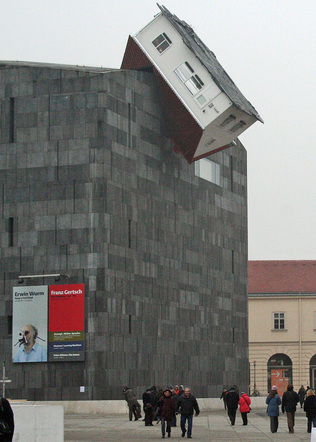
MuseumsQuartier
Museumsplatz 1
A-1070 Wien
The MuseumsQuartier Wien is a large complex of nine museums in Vienna, Austria. On the day of my visit I choose to view collections in three of the museums. Walking into the Quartier I was wowed by what I saw on the MOMUK (Museum Moderner Kunst). Literally sitting on the MOMUK. Could that be Dorothy's house? This was an impressive image that told me what I could expect to see inside. My expectations certainly were met. Pulling from the 20th and 21st centuries The MOMUK offers works that are new and experimental most of which requires unique spacing. The MOMUK is art specific. The museum mission statement states, "With its emphasis on Pop Art and Photorealism, taken from the Austrian Ludwig Foundation, Fluxus and Nouveau Réalisme, taken from the Hahn Collection, and Viennese Actionism, MUMOK offers a unique blend of art focusing on society and reality as well as of performative art of the 20th century." A journey into Vienna would not be complete without a visit to MOMUK - intelligent visual energy that will carry the discussion at a nearby Kaffe haus. Has anyone seen Toto?
http://www.mumok.at
Museumsplatz 1
A-1070 Wien
The MuseumsQuartier Wien is a large complex of nine museums in Vienna, Austria. On the day of my visit I choose to view collections in three of the museums. Walking into the Quartier I was wowed by what I saw on the MOMUK (Museum Moderner Kunst). Literally sitting on the MOMUK. Could that be Dorothy's house? This was an impressive image that told me what I could expect to see inside. My expectations certainly were met. Pulling from the 20th and 21st centuries The MOMUK offers works that are new and experimental most of which requires unique spacing. The MOMUK is art specific. The museum mission statement states, "With its emphasis on Pop Art and Photorealism, taken from the Austrian Ludwig Foundation, Fluxus and Nouveau Réalisme, taken from the Hahn Collection, and Viennese Actionism, MUMOK offers a unique blend of art focusing on society and reality as well as of performative art of the 20th century." A journey into Vienna would not be complete without a visit to MOMUK - intelligent visual energy that will carry the discussion at a nearby Kaffe haus. Has anyone seen Toto?
http://www.mumok.at
Centre Pompidou - Paris
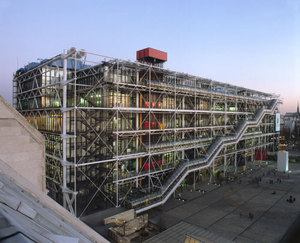
Place Georges Pompidou
75004 Paris, France
The Centre Pompidou in Paris serves host to some 6 million visitors a year and requires a quick pace be kept. Designed by Italian Renzo Piano and British designer Richard Rogers they created a space with "freedom of movement and flow, and an open approach to the exhibition areas." Approaching the building by foot from the far side of the Plaza I could not help but notice the large scale of the structure and the colorful functional embellishments of the exterior. The large open Plaza gave me a taste of what is inside - the freedom of movement. I was amazed at just how large the interior volume was too. The sight line ran at great lengths with each floor offering minimal wall separation. Having all the mechanical workings on the outside of the structure gave me an unobstructed space to move through inside. This built environment offers so much freedom of movement allowing me to scatter about amongst the every changing collections and exhibits. Housing the first collection of modern and contemporary art in Europe the Pompidou "spreads knowledge on the creative works of the twentieth century and the beginnings of the new millennium". A visit to the Centre Pomidou will refreshingly balance the slower energy of The Louvre.
http://www.centrepompidou.fr/
75004 Paris, France
The Centre Pompidou in Paris serves host to some 6 million visitors a year and requires a quick pace be kept. Designed by Italian Renzo Piano and British designer Richard Rogers they created a space with "freedom of movement and flow, and an open approach to the exhibition areas." Approaching the building by foot from the far side of the Plaza I could not help but notice the large scale of the structure and the colorful functional embellishments of the exterior. The large open Plaza gave me a taste of what is inside - the freedom of movement. I was amazed at just how large the interior volume was too. The sight line ran at great lengths with each floor offering minimal wall separation. Having all the mechanical workings on the outside of the structure gave me an unobstructed space to move through inside. This built environment offers so much freedom of movement allowing me to scatter about amongst the every changing collections and exhibits. Housing the first collection of modern and contemporary art in Europe the Pompidou "spreads knowledge on the creative works of the twentieth century and the beginnings of the new millennium". A visit to the Centre Pomidou will refreshingly balance the slower energy of The Louvre.
http://www.centrepompidou.fr/